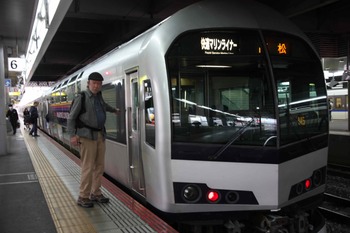Monday, 5 November 2012
 It's at this point, after ten days of hauling the Black Monster up and down staircases, in and out of elevators, on and off assorted trains with the associated worry about somewhere to stow the thing, that we bid farewell to the aforementioned encumbrance.
It's at this point, after ten days of hauling the Black Monster up and down staircases, in and out of elevators, on and off assorted trains with the associated worry about somewhere to stow the thing, that we bid farewell to the aforementioned encumbrance.
It's presence had, up to this point on the trip, been more or less inevitable. We had a week on the road, heading up into the cold country, with no idea how much warm clothing was going to constitute enough, and an understandable degree of caution as far as wet weather was concerned.
Having passed Kobe on the southward leg the day before we were back in territory where it was theoretically going to be warmer, so it made sense to take all the cold weather gear and despatch it, along with everything else deemed surplus to requirements, off to The Mother's place.
Despatching that material, of course, requires a container, and since the Black Monster is the only one on hand that's going to be big enough it's a case of Bye Bye Monster, see you on the final day, when we'll be resorting the possessions into two suitcases and loading Madam's suitcase with Japanese comestibles and reading matter.
There's a certain amount of economic sense in the move as well. Over the next two days we'd probably have been looking to stow the Monster in a coin locker at ¥600/day, thank you very much, so at an anticipated cost of ¥1600 to ship it back to Kobe, we're actually ahead if a third day in a coin locker had turned out to be necessary.
As it turned out, we got change out of ¥1500, so we were slightly further ahead, and a quick squiz at the coin lockers at Okayama Station suggested the Monster may have been too wide to fit in anyway.
Of course, having made that decision and bundled things up, Madam checks the weather and finds what looks like an extremely nasty cold front heading in our direction, having just killed two Japanese tourists on the Great Wall of China.
The day's agenda this time around involves a train ride over the Seto-ohashi Bridge to Shikoku, followed by a couple of hours in Okayama before heading down through Hiroshima to an overnight stop on the doorstep of Miyajima, so we're back in history and geography lesson time again.
Officially they might refer to the Seto-ohashi Bridge, but there are actually six bridges spanning five islands that connect Kojima in Okayama Prefecture on the main island of Honshu with Sakaide in Shikoku's Kagawa Prefecture. Built between 1978 and 1988, the thirteen kilometre stretch connecting Hitsuishi-jima, Iwaguro-jima, Wasa-jima, Yo-shima and Mitsugo-jima in the Seto Inland Sea and the larger islands on either side operates on two levels.
The upper level carries the Seto-Chuo Expressway with two lanes of traffic in each direction, while the JR Seto-ohashi Line and a lesser road share the lower level, with room to eventually accommodate a Shinkansen line in each direction. Of the six bridges, three are suspension bridges, two are oblique suspension bridges, and there’s one truss bridge.
The statistics associated with the ten-year US$ 7 billion project are impressive. The construction needed over three and a half million cubic metres of concrete and almost three-quarters of a million tons of steel before the bridge opened on 10 April 1988. Today, the bridge is one of three routes connecting Honshu and Shikoku, though it’s the only way to get to Shikoku by rail.